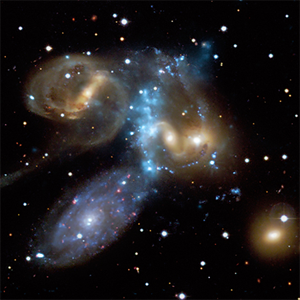I have long pondered whether to ever post the following example. It is possibly the single best example of visibly connected extragalactic objects with discordant redshifts in existence today. The physical connection between the objects is so plainly visible and their associated redshifts so disparate that one would think I would not hesitate to feature them on this website. Ironically, despite the overwhelmingly visible proof the following images provide, they also serve as stark reminders of just how stubborn and incredibly biased the current scientific community is in regards to discordant redshifts or any evidence that might throw the Big Bang Theory into question.

Stephan’s Quintet, also known as Hickson 92 and Arp 319, was discovered by Édouard Stephan in 1877 at Marseille Observatory located near Marseille, France. As the name suggests, the Quintet is comprised of five objects, each one a galaxy, as shown in the above Hubble Space Telescope image. They appear in close proximity to one another in the first compact galaxy cluster ever observed. Four of the galaxies share the same yellow color and center morphology including very similar redshifts that supposedly place them at very similar distances (using a so-called Hubble Constant value of 55 (km/s)/Mpc) as follows, viewed from left to right:
| Galaxy |
Redshift (z) | Distance (Mly) |
| NGC 7319 | 0.022507 | 398.1 |
| NGC 7318B | 0.019260 | 340.9 |
| NGC 7318A | 0.022115 | 391.2 |
| NGC 7317 | 0.022012 | 389.4 |
The fifth galaxy, NGC 7320, with a distinctive bluish color and spiral morphology is clearly interacting with NGC 7318A and B. Streamers of stars and gas from NGC 7320 are entrailed within their intertwined arms while long filaments spread outward and mix with the broad arms of NGC 7319. Everyone, including astronomers and cosmologists alike, would be in absolute agreement with this observation if not for the peculiar fact that the redshift of NGC 7320 is only 0.002622 z. This places it at a mere 46.6 million light years away or less than an eighth of the average distance of 380 million light years (Mly) for the other four galaxies according to the distance/acceleration interpretation of redshifts. Yet despite its discordant redshift and apparent extreme separation, the interaction of NGC 7320 with its companions has been well observed in multiple wavelengths:
| This mixed infrared-optical wavelength image shows unusually hot hydrogen gas as green streamers of H-alpha emissions connecting the arms of NGC 7318A and B with the galaxies NGC 7319 and 7320. The original full size image is available from the Spitzer Space Telescope site where the accompanying article describes the discordant NGC 7320 as “the large spiral at the bottom left of the image” that is a “foreground object and is not associated with the cluster”. |  |
| This mixed x-ray-optical image shows the same hot hydrogen as light blue streamers connecting the same four galaxies and possibly even the fifth, NGC 7317. The original image and its individual layers are available at the Chandra X-Ray Observatory website where once again the connection with discordant NGC 7320 is flatly denied. The article on the main object page describes NGC 7320 as a “prominent foreground galaxy” that is “not a member of the group”. |  |
These well-documented observations should be accepted as definitive proof that redshifts are not indicative of distance. Instead they are once again explained away as mere coincidence or otherwise ignored completely. When I have considered posting Stephan’s Quintet in the past I have hesitated because I feared it would serve to demotivate me in the fight to get the truth out to the public. If the scientific community will deny even this example what hope is there to ever convince anyone to accept a different interpretation of redshift measurements? Surprisingly, while preparing this article, I found myself inspired by the fact that the included observations and measurements are at least out there and available for anyone to see. The evidence does really exist, it is not too difficult to obtain, and many times it is very plain to see its implications. I also found inspiration in the recent encouragement I received from some of the readers of this site. Thank you all again for your support.
So I will continue to post, and continue to hope that one day we will move past the current Ptolemaic-like view of the Universe and move towards solving its real mysteries! I will also continue to encourage all visitors to this site to pursue their own observations and please feel free to contribute any examples to the cause.
Shannon
